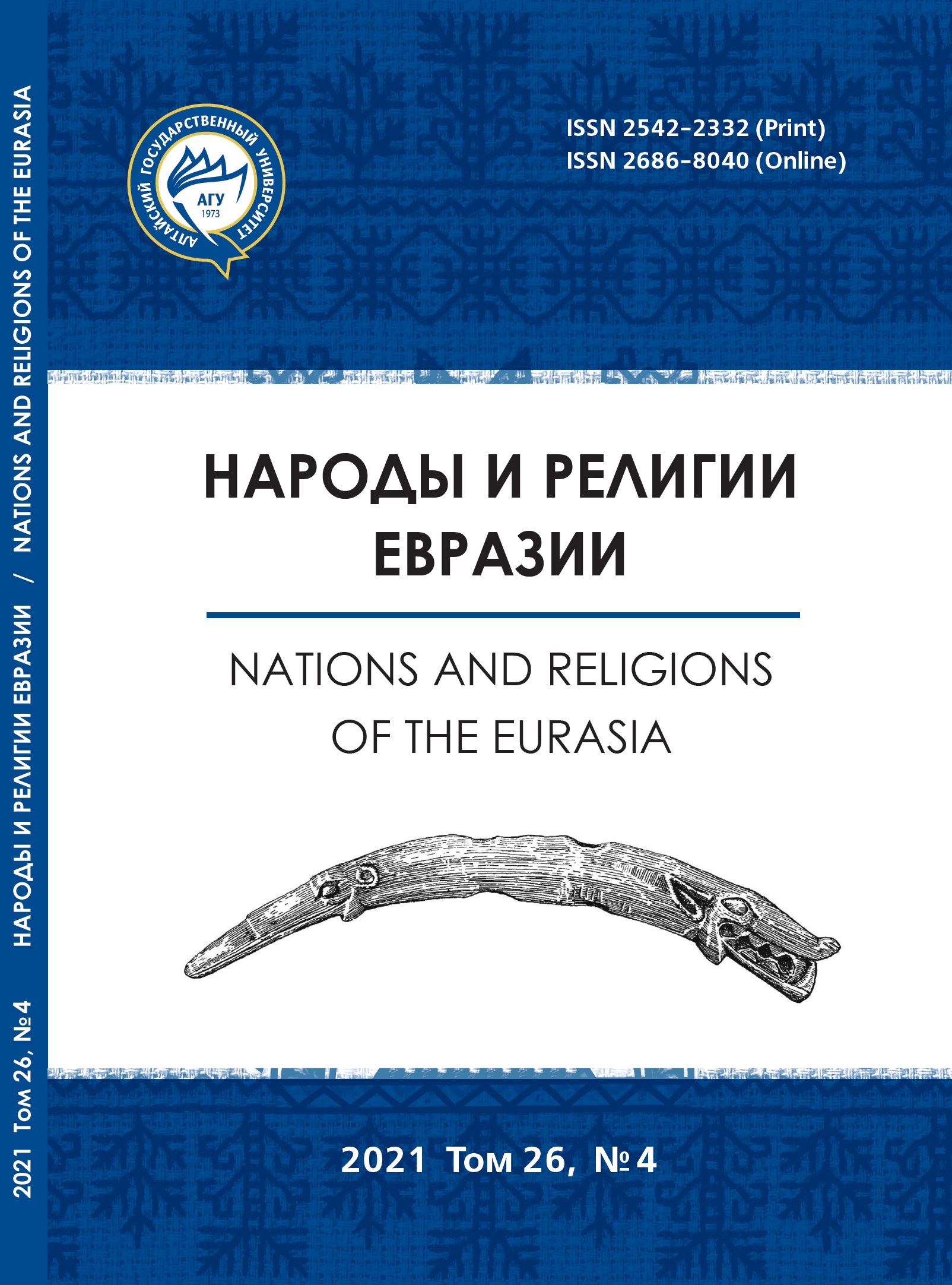About the "crassus hepothesis" and the hellenic mythological subjects in China and Mongolia
Main Article Content
Abstract
In modern domestic science, Mark Licinius Crassus former legionaries participation in the battle of Talas (36 BC) on Xiongnu side hypothesis are quite strong. Among other things, this assumption explains some ethno-cultural phenomena to the south of the Eurasian steppe belt. In this work, relying on artifacts from western China, we present the point of view according to which there was another much more voluminous and long-lived source of Greco-Roman influence on the Celestial Empire. Judging by a number of finds, in the first half of the 1st millennium AD Asia there were a number of centers for the artifacts in the Hellenistic style production primarily decorated with mythological (for example, stories from the Trojan War cycle) and religious stories (primarily associated with the fertility and winemaking cult). We are talking about a number of centers because the artifacts stylistics various groups with the undoubted Greek influence in all cases differs markedly. A Hellenistic trace can also be assumed when considering the "unusual warriors" who sided with the Xiongnu ruler Zhi Zhi against the Han troops. As an analogy, the author also draws on later finds Mediterranean by origin in China (up to the 8th century AD) thus proving that the Great Silk Road having developed to the end of the II century BC played not only an economic but a cultural and religious role influencing, among other things, Central Asia and the Yellow River basin.
Downloads
Metrics
Article Details

This work is licensed under a Creative Commons Attribution 4.0 International License.
References
Киселев В. И. Армия Рима (от Цезаря до Константина) // Новый солдат: военно-исторический альманах. 2002. № 27. 52 с.
Комиссаров С. А., Васенькин В. В., Харрис Д. Римляне в Китае: перспективы поиска // Общество и государство в Китае : тез. докл. XXII науч. конф. 1991. Ч. 1. С. 92–94.
Полосьмак Н. В., Богданов Е. С., Д. Цэвээндорж Д. Двадцатый ноинулинский курган. Новосибирск : ИНФОЛИО, 2011. 184 с.
Светлов Р. В. Пирр и военная история его времени. СПб. : Изд-во С.-Петерб. ун-та, 2006. 355 с.
Харрис Д., Васенькин В. В., Комиссаров С. А. Столкновение Римской и Ханьской империй (в контексте военной истории) // Россия и Восток. Археология и этническая история : материалы IV Междунар. науч. конф. «Россия и Восток: проблемы взаимодействия». Омск, 1997. С. 26–27.
Шульга Д. П. Международный выставочный проект «Терракотовая армия — восьмое чудо света: путь оружия в судьбе Поднебесной» // Вестник НГУ. Серия: История, филология. 2012. Т. 11, вып. 4. С. 216–218.
Christopoulos L. Hellenes and Romans in Ancient China // Sino-Platonic Papers. 2012. Vol. 230. 79 p + maps (in English).
Christopher M. A. Greek Hoplites in an Ancient Chinese Siege // Journal of Asian History. Vol. 45. P. 17–37 (in English).
Hirth F. The Mystery of Fu-lin // Journal of the American Oriental Society. 1913. Vol. 33. P. 193–208 (in English).
Hirth F. China and the Roman Orient: Researches into their Ancient and Medieval Relations as represented in old Chinese Records. Munich: GEORG HIRTH, 1885. 368 p. (in English).
Hoppál K. The Roman empire according to the ancient chinese sources // Acta ant. hung. № 51. 2011. Р. 279–299 (in English).
Hoppál K. Chinese Historical Records and Sino-Roman Relations A Critical Approach to Understand Problems on the Chinese Reception of the Roman Empire // Res Antiquitatis, 2nd series. 2019. Vol. 1. P. 63–81 (in English).
Jones R. A. Centaurs on the Silk Road: Recent Discoveries of Hellenistic Textiles in Western China // The Silk Road. 2009. P. 23–32 (in English).
Li Qiang. Roman coins discovered in China and their research. // Eirene. Studia Graeca et Latina. 2005. Vol. 51. P. 279–299 (in English).
Mclaughlin R. The Roman Empire and the Silk Routes: The Ancient World Economy and the Empires of Parthia, Central Asia and Han China. Barnsley: Pen & sword history, 2016. 400 p. (in English).
Zhou R., An L., Wang X. et al. Testing the hypothesis of an ancient Roman soldier origin of the Liqian people in northwest China: a Y-chromosome perspective. J Hum Genet 52, 2007. P. 584–591 (in English).
Го Юньянь. Чжунго фасяньдэ байчаньтин цзиньби цзи ци фанчжи пинь яньцзю [郭云艳 。中国发现的拜占廷金币及其仿制品研究。天津: 南开大学研究生院, 2006] Исследование обнаруженных в Китае византийиских монет и их имитаций. Тяньцзинь: Отдел аспирантуры ун-та Нанькай, 2006. 286 с. (на кит. яз.).
Гэ Чэнъюн. Цзуй Фулинь: Сила цзю шэнь цзай чжунго [葛承雍。«醉拂菻» :希腊 酒神在中国 // 文物2018年第1期] «Хмельной средиземноморец»: греческий бог Бахус в Китае. Вэньу, 2018. № 1. С. 58–69 (на кит. яз.).
Гэ Чэнъюн. Цун чуту хань чжи тан вэнь у кань оу я вэньхуа цзяолю и хэнь [葛承雍。从出土汉至唐文物看欧亚文化交流遗痕 // 故宮博物院院刊 2015年第3期] Культурные связи Европы и Азии по данным памятников наследия от Хань до Тан // Гугун боуюанькань. 2015. № 3. С. 111–125 (на кит. яз.).
Ло Фэн. Хухань чжицзянь: «Сычоу чжилу» юй сибэй лиши каогу [羅丰。胡漢 之間:«絲绸之路» 與西北歷史考古。北京: 文物出版社,2004] Между иноземцами и ханьцами: «Шёлковый путь» и историко-археологические исследования Северо-запада. Пекин: Вэньу чубаньшэ, 2004. 515 с. (на кит. яз.).
Сюй Годун. Ханьдай сиюй духуфуцзун дучжэн цзи дуй лома шан дуй дэ баоху [徐国栋。汉代西域都护府总督郑吉对罗马商队的保护 // 法治研究] Охрана караванов с римскими товарами со стороны ханьского генерал-губернатора Чжэн Цзи в Западном крае // Фачжияньцзю (Исследования правового управления). 2014. № 3. С. 126– 131 (на кит. яз.).
Чжан Сюйшань. Цзинцзяо дунцзянь цзи чуань жу чжунго дэ сила-байчжаньтин вэньхуа [张绪山。景教东渐及传入中国的希腊 —拜占庭文化 // 世界历史2005年 6期] Распространение несторианства на восток и греко-византийское культурное влияние в Китае. Шицзе лиши. 2006. № 6. С. 76–88 (на кит. яз.).
Чэнь Бинъин. Гудай миньцзу [陈炳应。古代民族。兰州: 敦煌文艺出版社,2003 。212页] Древние этносы. Ланьчжоу: Дуньхуанский литературно-художественный издательский дом (Дуньхуан вэньи чубаньшэ), 2003. 212 с. (на кит.яз.).
Ян Гунлэ. Сычоу сисяо даочжи Лома диго цзинцзи шуайло шо юаньлю бяньси [杨共乐。丝绸西销导致罗马帝国经济衰落说源流辨析 // Collected Papers of History Studies 2011年1期] Критический анализ гипотезы о взаимосвязи торговли по Шелковому пути и упадка Римской империи // Collected Papers of History Studies. 2011. № 1. С. 69–74 (на кит.яз.).


 https://orcid.org/0000-0001-5820-1743
https://orcid.org/0000-0001-5820-1743